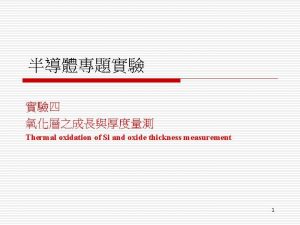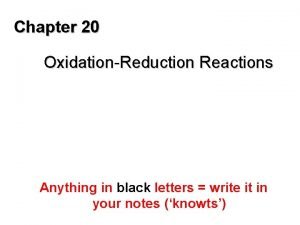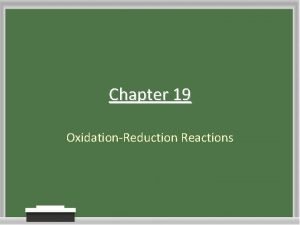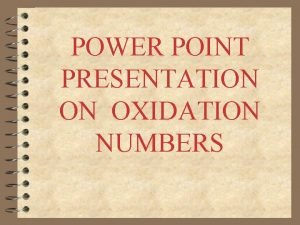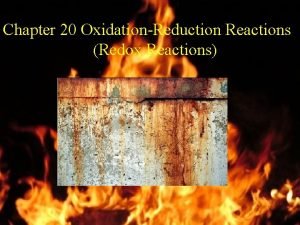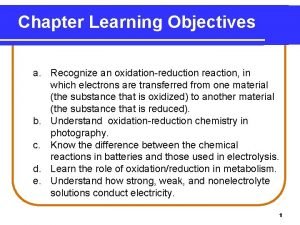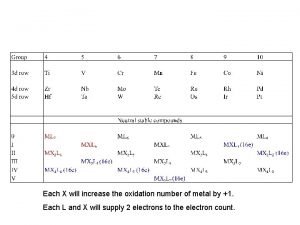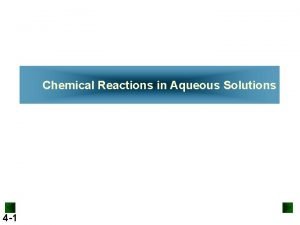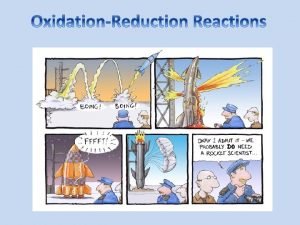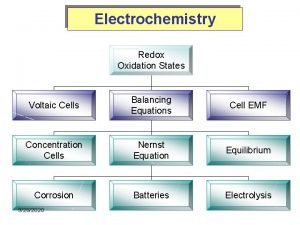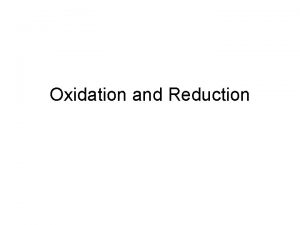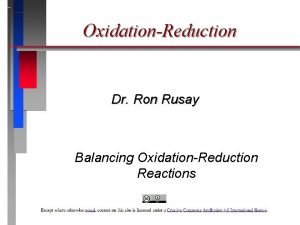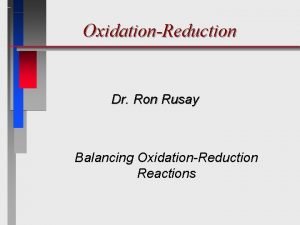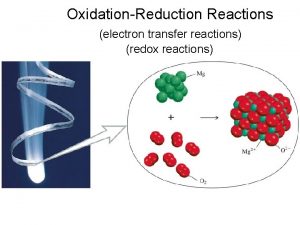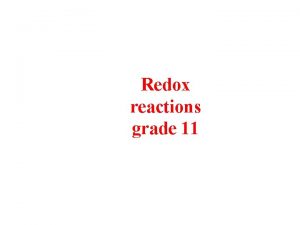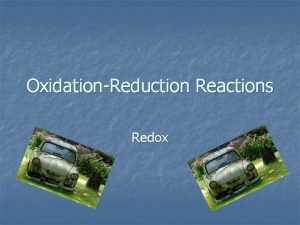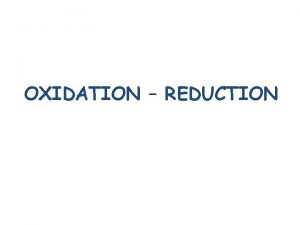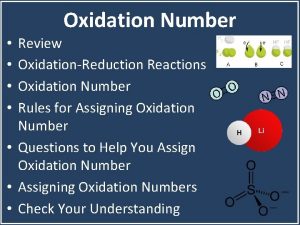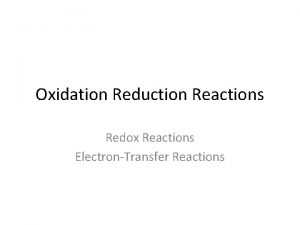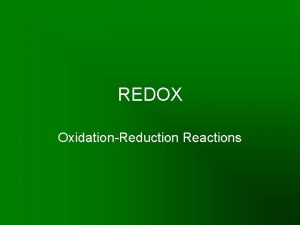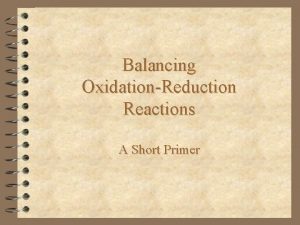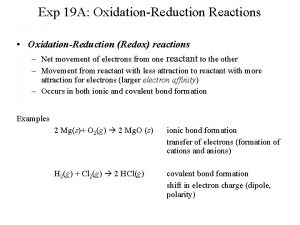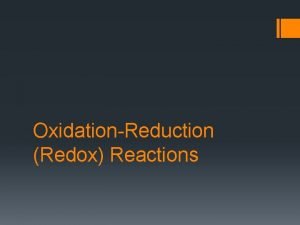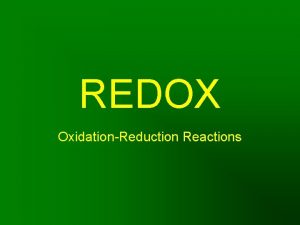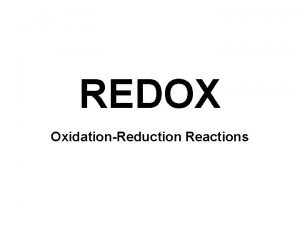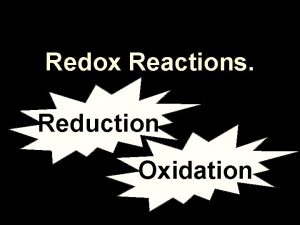4 4 OxidationReduction Reactions An oxidation occurs when



















- Slides: 19

4. 4 Oxidation-Reduction Reactions • An oxidation occurs when an atom or ion loses electrons. • A reduction occurs when an atom or ion gains electrons. Aqueous Reactions 1

Oxidation-Reduction Reactions One cannot occur without the other. Aqueous Reactions 2

Oxidation Numbers • To determine if an oxidation-reduction reaction has occurred, we assign an oxidation number to each element in a neutral compound or charged entity. • See rules for assigning oxidation numbers in text, page 139. You must remember these rules. • Oxidation numbers are written with the sign first, then the number. For example, O is -2, Ca is +2 • The oxidation numbers for a neutral compound must add up to zero. The oxidation numbers for an ionic compound must add up to the charge on the ion. • Remember OIL RIG for what is oxidized and reduced: Oxidation is loss of electrons Reduction is gain of electrons Aqueous Reactions 3

Assigning Oxidation Numbers Aqueous Reactions 4

Displacement Reactions • In displacement reactions (single displacement reactions), ions in solution are displaced through oxidation of another element. • The ions that caused the oxidation are then reduced. • In the case of copper reacting with silver ions in solution, the copper metal is placed in solution and silver metal is formed as a solid. See figure 4. 14. Aqueous Reactions 5

Displacement Reactions In this reaction silver ions oxidize copper metal. The oxidation of copper is accompanied by the reduction of silver to Ag(s). Cu (s) + 2 Ag+ (aq) Cu 2+(aq) + 2 Ag (s) Aqueous Reactions 6

Displacement Reactions The reverse reaction, however, does not occur. x Cu 2+ (aq) + 2 Ag (s) Cu (s) + 2 Ag+ (aq) Why? Aqueous Reactions 7

• Reference the activity series table on the following slide or in the text. In it you will see that copper lies above silver in ease of oxidation. Since copper is already oxidized, as Cu+, silver cannot replace it since it is not as easily oxidized. • Metals in the activity series replace, or oxidize, metals below them in the series. Aqueous Reactions 8

Activity Series Aqueous Reactions 9

4. 5 Concentration of Solutions • Two solutions can contain the same compounds but be quite different because the proportions of those compounds are different. • Molarity is one way to measure the concentration of a solution. moles of solute Molarity (M) = volume of solution in liters Aqueous Reactions 10

Molarity Calculations Aqueous Reactions 11

Interconverting Molarity, Moles and Volume • The definition of molarity contains three quantities: molarity (M), moles of solute, and liters of solution. – To solve for moles, multiply liters of solution X molarity • Notice that the units for volume cancel out – To solve for volume of solution, divide moles of solute by the molarity • Notice that the units for moles cancel out Aqueous Reactions 12

Preparation of a Solution • See fig 4. 16 in text • For example, you want to prepare 0. 250 L of 1. 00 M solution of Cu. SO 4 • The molar mass of Cu. SO 4 is 159. 6 grams per mole – 159. 6 grams in 1. 00 L of solution = 1. 00 M – 39. 90 grams in 0. 250 L of solution = 1. 00 M • Weigh-out 39. 90 grams of Cu. SO 4 and place it into a 250 -m. L volumetric flask. • Add a small amount of water to the solute in the flask. Swirl to dissolve. • Add additional water to the calibration mark. • Shake the stoppered flask to ensure complete mixing. Aqueous Reactions 13

Dilution Mconc x Vconc = Mdilute x Vdilute How many m. L of 1. 00 M HCl must be diluted to make 350 m. L of 0. 250 M HCl solution? How many m. L 2. 50 M Na. OH must be diluted to make 0. 500 L of 0. 750 M Na. OH solution? Aqueous Reactions 14

4. 6 Solution Stoichiometry and Chemical Analysis Aqueous Reactions 15

• In stoichiometric calculations, if you know the quantity of one reactant (or product) in a balanced chemical reaction, you can calculate the quantities of other reactants and products. When working with solutions of known molarity, we use molarity and volume to determine the number of moles. • Moles of solute = M x L soln • For example: how many grams of Ca(OH)2 are required to neutralize 25. 0 m. L of 0. 100 M HN 03? (See sample exercise 4. 15. Also, try solving the practice exercises to see if you can get the posted answers. ) Ca(OH)2 + 2 HNO 3 2 H 2 O(l) + Ca(NO 3)2 • Calculate number of moles of HNO 3 Moles = Liters x M • Use moles of HNO 3 and mole ratio to solve for grams of Ca(OH)2 grams Ca(OH)2 = moles HNO 3 x mole ratio x molar mass of Ca(OH)2 Aqueous Reactions 16

Titration • The analytical technique in which one can calculate the concentration of a solute in a solution. Titrations can be conducted for acid-base reactions, precipitation, or redox reactions. • An acid-base titration is shown below. The chemist is trying to determine the concentration of an acid solution. Aqueous Reactions 17

• The sample of the solution of unknown concentration is combined with a reagent solution of known concentration, called a standard solution. • In the acid-base titration example shown, a standard Na. OH solution is added to a specific volume of the acid solution of unknown concentration until the neutralization reaction between the HCl and the Na. OH is complete. • The point at which stoichiometrically equivalent quantities are combined is known as the equivalence point of the titration. • How does one know the equivalence point has been reached? Acidbase titrations use dyes known as indicators. An indicator called phenolphthalein (phph) is colorless in an acidic solution but pink in a basic solution. • Na. OH is added drop by drop to the acid solution containing phph. The drop of Na. OH added after the equivalence point is reached turns the clear solution pink. The color change signals the end point of the titration which usually coincides very closely with the equivalence point. Aqueous Reactions 18

• Knowing the total volume of Na. OH added to the acid solution to bring about neutralization, a student/chemist can use stoichiometry calculations to determine the concentration of the acid. • See sample exercise 4. 16 and practice exercises. • For example: A student is trying to determine the concentration of an Na. OH solution. She neutralizes a 20. 0 -m. L sample of the Na. OH solution with 45. 7 m. L of 0. 500 M H 2 SO 4. What is the molarity of the Na. OH solution? – Write the balanced equation: H 2 SO 4 + 2 Na. OH Na 2 SO 4 + 2 H 2 O – Calculate moles of H 2 SO 4 used to neutralized the Na. OH: – Use the mole ratio to calculate moles of Na. OH in sample: – Calculate molarity of the Na. OH: Aqueous Reactions 19
 Locos bird's beak
Locos bird's beak Oxidation–reduction reactions
Oxidation–reduction reactions Oxidation reduction
Oxidation reduction What is a redox reaction
What is a redox reaction Chapter 19 review oxidation-reduction reactions answers
Chapter 19 review oxidation-reduction reactions answers Chapter 19 review oxidation-reduction reactions answers
Chapter 19 review oxidation-reduction reactions answers Explain oxidation
Explain oxidation Reducing agent strength table
Reducing agent strength table Oxidation–reduction reactions
Oxidation–reduction reactions Oxidation and reduction in galvanic cells
Oxidation and reduction in galvanic cells Chemistry unit 5 reactions balancing reactions worksheet
Chemistry unit 5 reactions balancing reactions worksheet How to write redox half reactions
How to write redox half reactions Section 2 classifying chemical reactions worksheet answers
Section 2 classifying chemical reactions worksheet answers Types of reactions
Types of reactions Section 2 classifying chemical reactions worksheet answers
Section 2 classifying chemical reactions worksheet answers Oxidation number of nh2
Oxidation number of nh2 Redox reaction in alkaline medium
Redox reaction in alkaline medium Oil rig oxidation
Oil rig oxidation Topic 19
Topic 19 Oxidation or reduction
Oxidation or reduction
